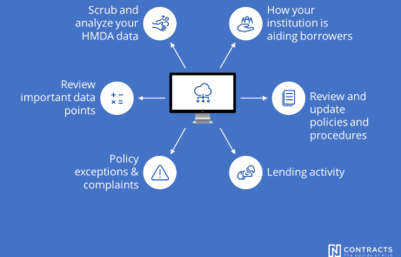Successfully telling your institution’s HMDA data story requires a series of steps that starts with collecting data and ends with a careful analysis. We offered up our best advice and tips for an effective, efficient, and informative HMDA data process in our on-demand webinar Understanding Your HMDA Data.
Table of contents
Let’s take a closer look at the HMDA data cycle.
HMDA data cycle

Collect and record HMDA data.
Your HMDA data must be collected, scrubbed and reported. Don’t let your data collection slide. If you’re not regularly scrubbing and analyzing your data and instead save this step for the last minute, you’re adding unnecessary risk to the process. You might not have time to correct mistakes, and you may have missed an opportunity to identify potential fair lending issues.
Data integrity is the foundation of HMDA. It’s one of the first things examiners look at, and bad data can expose problems within your compliance management system (CMS).
Related: What Should I Do Before Submitting My HMDA Data?
Keep track of how your FI is aiding borrowers
The CFPB says examiners will look at the good-faith efforts of lenders to help borrowers. Make sure your institution is tracking its programs and the number of customers helped. Why? Knowing your story always helps to explain to a regulator why something may appear to be disparate treatment when it really isn’t.
Review and update lending policies.
Keep your written policies up to date. Every change, including standards and procedures, should be documented -- whether it’s introducing a new loan program or modifying an existing one.
It’s not enough to update policies. Identify every employee that needs to be familiar with lending policies, and make sure they have access to them. Employees also need to understand them. Training should be tailored to an employee’s job (mortgage underwriting, small business lending, consumer loans, etc.).
Board and management oversight of lending policies is a must. Significant changes should be approved by the board, management or your institution’s lending committee.
Free Download: Policies as a Power Tool: Creating Policies that Get the Job Done
Review lending activity.
It’s essential to analyze lending activities to determine if your institution is complying with fair lending laws. This analysis should include every branch, loan officer, and channel (e.g. mortgage, small business, and retail).
HMDA data analytics is a complicated task that involves specific math and statistics training. If your institution doesn’t have the expertise to quickly and thoroughly analyze HMDA data, consider using a software solution like Nlending.
Policy exceptions and complaints.
Underwriting policy standards should be clearly defined, and procedures for exceptions should be documented. Policy language should not leave room for subjectivity or discretion. This includes exceptions and fee waivers.
Underwriting policy standards should have set minimums for:
- Debt-to-Income (DTI)
- Loan-to-Values (LTV)
- Type of collateral
While flexibility can help loan officers meet consumer needs, it needs to be paired with a monitoring and tracking process that look at lending both as a whole and by market area. Your policy should outline actively managed and monitored compliance controls (i.e. policies, procedures, monitoring, reporting, management participation, etc.) for exceptions and complaints to ensure they don’t lead to violations of fair lending laws.
Review important data points.
Proactively look for any patterns or practices within your data. These include underwriting, pricing, and terms.
If you see problem spots, do a deeper analysis of the disparity, including regression testing. Make sure you also analyze your HMDA data for redlining, fair lending issues, and the Community Reinvestment Act (CRA), if applicable, to look for potential risk.
Disparities don’t always mean discrimination, but you won’t know until you dig in. An analysis can help you find weaknesses in your CMS such as the need to update policies or procedures or improve training.
Regulators want to see that you are proactively analyzing your data and that you’re taking that analysis seriously, including monitoring your data, mitigating risk, and remediating issues.
Related: Everything You Need to Know about Fair Lending Regression Analysis
What should you do before comparing your HMDA data to peer data?
Before you start looking at peer data, you have to be familiar with your own data and where you have a significant number of applications. Look at your analysis areas to see where you are lending, where you have branches, what’s your market, and what’s your reasonably expected market area (REMA).
Once those areas are identified, then look at peers doing similar business in those areas. Look at outliers (both for peers and national averages) but remember: Just because you’re outperforming your peers doesn’t guarantee you’re off the hook. Being the best of a bad crop of lenders won’t get you anywhere with examiners.
They also don’t accept “we don’t have a branch in that area” as a reason for lackluster lending in majority-minority and low-income neighborhoods. You need to demonstrate boots on the ground.
What HMDA info should be included on board reports?
The board of directors should be given high-level executive summaries when it comes to HMDA data. Use tables and charts to emphasize the most important points of your findings, remediation, and any other important points that help the board see and understand your story. It can also help to include data on both institutional and industry challenges. Additionally, make sure you are reviewing past audit reports to see if your board reporting has been cited and why. That way you can include any additional information needed and not have repeat findings.
If the data is for a committee, your reporting can include more details since that audience is likely more informed about HMDA and more actively managing lending compliance risk. If it’s for senior management, go even more in-depth.
How effective is your fair lending compliance system?
Find out with our free interactive download.
